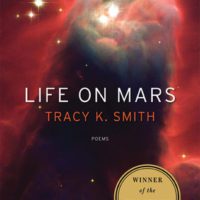Tracy K. Smith’s third book of poetry, Life on Mars, marks an interesting point in a talented poet’s career. While her poetry is solidly academic, in this volume Smith chooses to delve deeply into popular culture to undertake a science-fiction-y poetic meditation. The book is driven by the emotional energy resulting from a death—that of a father—with a focus on the different things life can be imagined to be. Meanwhile, the red planet serves as a multi-layered touchstone, both present and inhabitable as well as distant and indefinable. The poetic result of this mixing of elements is a work that achieves great evocative power.
In four sections, Smith explores ways that humanity has succeeded and (more often) failed to form life. In her hands, the title can take on multiple meanings, from an idea about what life could be on another planet, to images of what earth-life might look like from there, to an implied general question posed to humanity, “Are you from Mars?” She seeks to understand and treat the ways both science and popular culture imagine outer space, weaving back and forth between the two discourses. At the same time that space is a subject to be analyzed, it is also one capable of eliciting emotional responses. Moreover, the universe is a place at once open-ended and confining, an entity significant not only in content but in form, and Smith develops these aspects by toying with space as form, making use of extra spaces between lines in many poems while using single space format in others.
There is a sense in which this is a deeply religious book in that Smith continues what she began in her first book, The Body’s Question, which is to figure out the connection between body and soul. In this volume she adds to this effort the quest to learn where exactly one can find God and whether some kind of after-life exists somewhere in all that space of the beyond. The book is framed by the poem “The Weather in Space,” which asks, “Is God being or pure force? The wind/Or what commands it?” Riveted by the rich yielding of scientific knowledge, Smith explores not just the science of space but also the life-stuff surrounding earth-bound understandings of it, whether it be literary, religious, or the kind of knowing that belongs to popular culture: Charlton Heston and David Bowie are important figures in the first section of the book, standing as iconographic pillars of a retro Space Age.
The most emotionally powerful parts of the book are two lengthy poems. The first, entitled “The Speed of Belief,” takes up almost all of section two and is an elegy on the passing of her father. Smith wants to hold out hope that she can reunite with him, asking
What happens when the body goes slack?
When what anchors us just drifts off toward. . . .
What that is ours will remain intact?
There would seem to be a core paradox for Smith: her father was a scientist working on the Hubble Telescope, but this tremendous thing he has helped create cannot allow anyone to see far enough to find whatever beyond he might now inhabit.
Equally powerful is the long poem in section three, “They May Love All That He Has Chosen and Hate All That He Has Rejected,” which is leveled at hate-crimes and the white supremacists who commit them, presenting a number of fictitious postcards written by real-life victims to their real-life killers. This writing-back is achingly tragic; however, the poem’s power to disturb becomes even greater with its provocative conclusion in which Smith offers a final comment on an ambiguous “they.” The final part of six begins with
Line them up. Let us look them in the face.
They are not as altogether ugly as we’d like.
Unobserved, they go about their lives
With familiar concentration. They pay
Their debts down bit by bit. They tithe.
The “they” being discussed is ambiguous: it could be the victims, but it more likely refers to the criminals themselves, especially in light of the closing lines
Touched by understanding, ready to stand
And go forth into that unmistakable light.
The good fight. One by one they rise,Believing what to do, bowing each head
To what leads. And, empty of fear, buoyant
With the thrill of such might
they go.
Showing the humanity of the killers, even though that humanity simultaneously casts itself as monstrous, jars with the rest of the poem. It also makes the piece one of the most intriguing and memorable in the book.
Section three generally presents a view of Earth and its grave social and environmental problems from what might be imagined as the vantage point of another planet. Such is the thrust of “Life on Mars,” although the poem carries the implication that the inhabitants of Mars—whether colonists from Earth or some other kind of organism—may themselves have such horrors to look forward to. From this wide perspective, Smith moves into a more interpersonal focus in section four. “Song” perhaps best embodies this intimacy, with its focus on the hands of someone so close to the poet,
What they won’t forget year after year.
Or now. Resting on the wheel or the edge of your knee.
I am trying to decide what they feel when they wake up
And discover my body is near. Before touch.
Pushing off the ledge of the easy quiet dancing between us.
Readers may find Life on Mars to be uneven in certain ways. The kind of emotion-provoking machinery that drives “The Speed of Belief” does not maintain its intensity throughout the book, even in “They May Love . . .” At the same time, the reader might be a little disappointed that Mars itself does not figure more prominently: the literary, cultural, and scientific lore of that planet could have offered additional directions for development. Instead, again, Mars remains shadowy, a kind of unspoken destination at times, at other times an unacknowledged place of observation. Read a different way, its obscure marginality in the book makes it all the more intriguing and important as it is as inaccessible and invisible as heaven might be thought to be.
Aside from these (debatable) weaknesses, however, the strength of this book and Smith’s ability generally can hardly be refuted. She has established herself as a poet who continues to work out the nuances of body and spirit while also ranging literally into other parts of the universe. While the book may leave some expectations unfulfilled, its technical adroitness is beautiful to encounter, and Smith’s ability to render complex hopes and emotions intelligible is tremendous.





One response
I don’t think this book is as much about god as several people in the book club have suggested. I get a strong impression of god as another phenomena like dark matter in the anthropic principle sense. The poems It & Go. and Cathedral Kitsch certainly seem to undermine religious. It is more akin to SETI than a search for faith, just another aspect to know or to posit internally plausible scenarios which may (or may not) include god.
Early on in the book in viewing a church she says, “…what glistens back\Is high up and cold. I feel\Man here. The same wish\That named the planets.” And it It & Co., “Is It us or what contains us? How can It be anything but an idea…” and later, “…We/have gone looking for It everywhere:\In Bibles and bandwidth…”.
Much later in the book in The Universe as Primal Scream, death is offered as an equal candidate with god and a mechanical godless but mysterious universe as It: “Whether it is our dead in Old Testament robes,\Or a door opening onto the roiling infinity of space.\Whether it will bend down to greet us like a father,\Or swallow us like a furnace. I’m ready\To meet what refuses to let us keep anything\For long.”
She approaches these subjects with the quasi-scientific rigor of the ancients, standing up hypotheses which cannot be proved or disproved, anxiously inquisitive and open minded, for our consideration.
Click here to subscribe today and leave your comment.